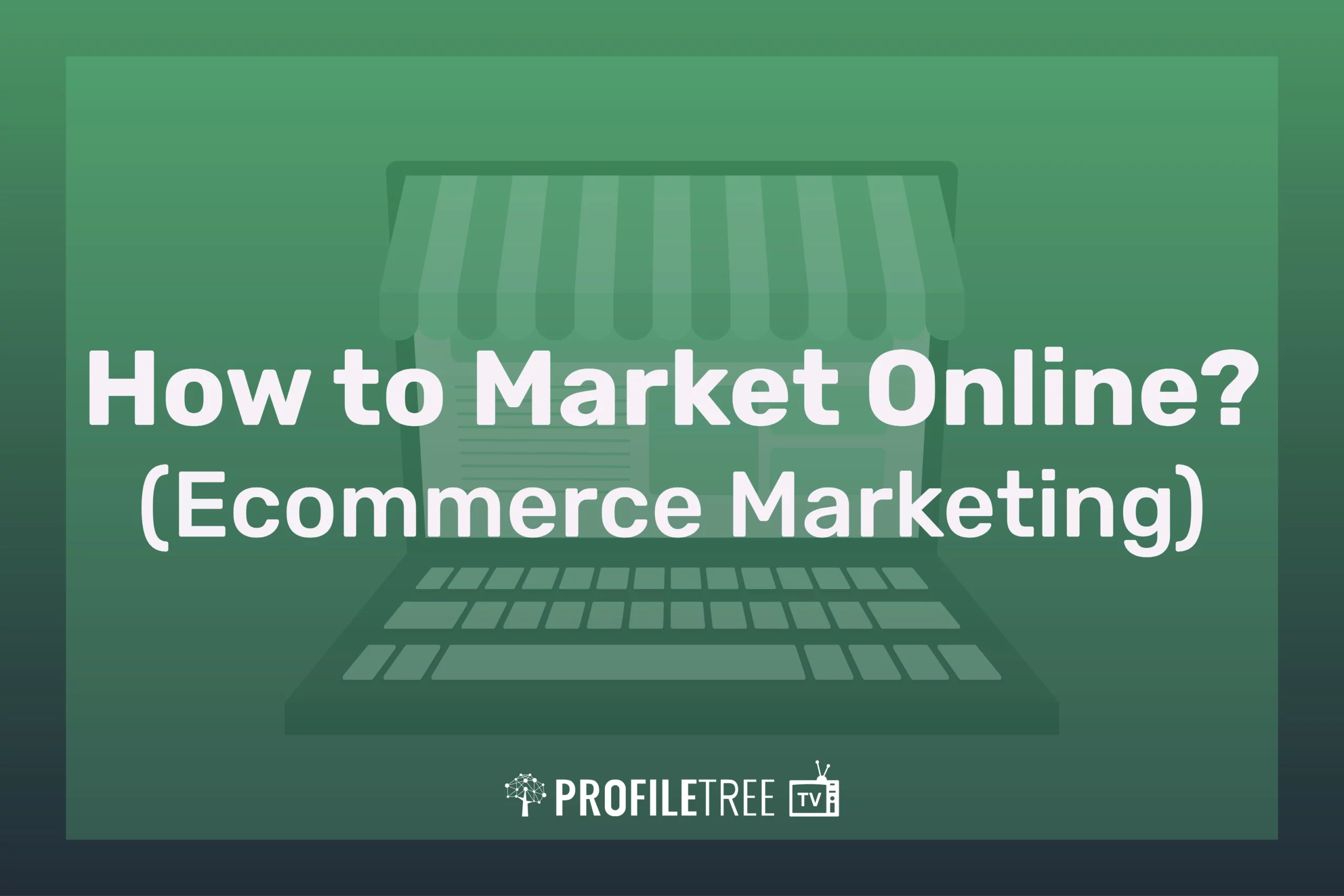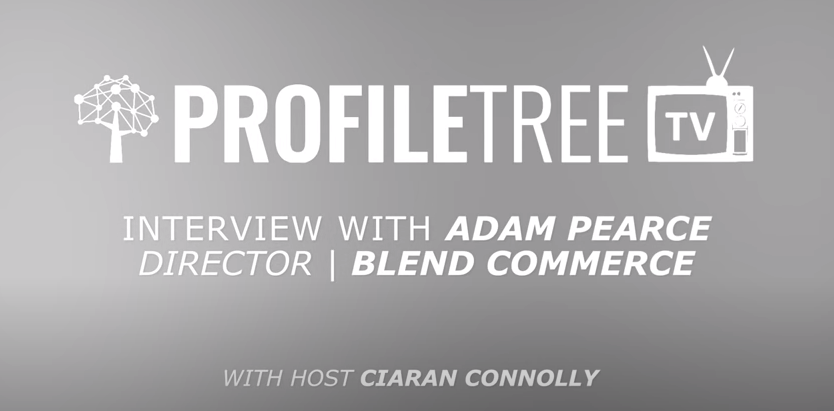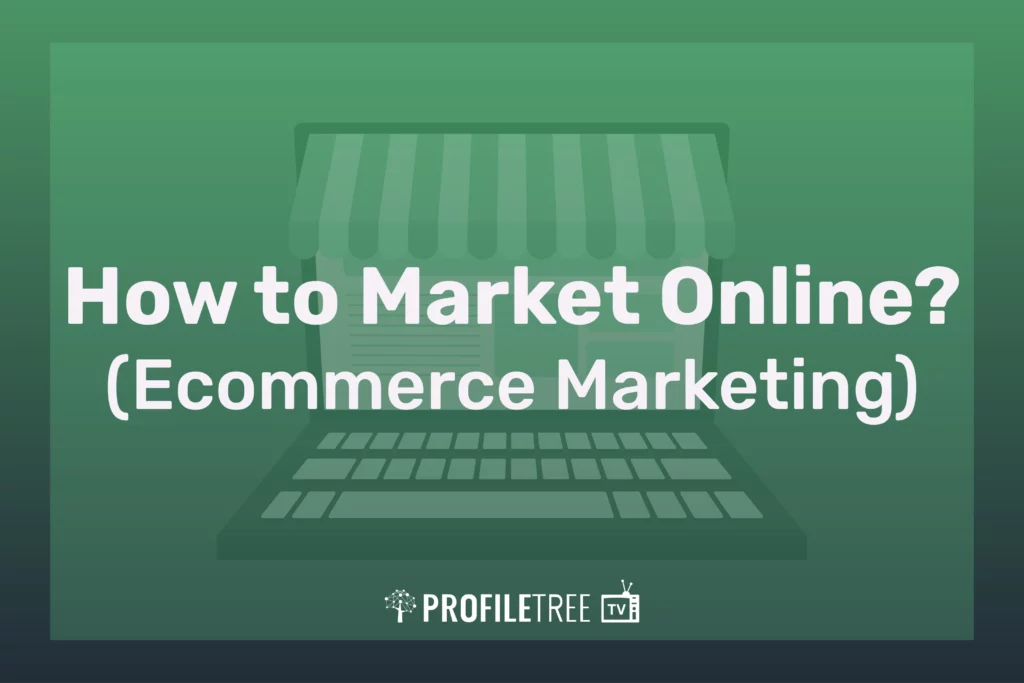Ecommerce marketing refers to the strategies and tactics used by online businesses to attract customers and drive sales of products or services through their website or mobile app. As global retail ecommerce sales continue to rapidly rise towards nearly $7 trillion, implementing an effective ecommerce marketing plan has become imperative for brands selling directly to consumers through digital channels.
Key components of a comprehensive ecommerce marketing strategy include search engine optimization, pay-per-click advertising, affiliate partnerships, email marketing, social media promotions, retargeting campaigns, content creation and more. By leveraging data-driven testing and attribution modeling, marketers can optimize their spending across channels to maximize return on investment.
How to market online? ProfileTree welcomed Adam Pearce of Blend Commerce to our studio to discuss online selling, Shopify and much more.
The Blend Commerce co-founder, speaking via a Zoom video link, shared some of his Shopify and online marketing expertise.

Table of Contents

Ecommerce Marketing: How to Market Online? Combining Shopify With Marketing
He began by outlining the specialism offered to businesses by Blend Commerce, who simply aim to help companies make sure their Ecommerce offer is “the best it can possibly be”.
“We sometimes say we’re a holistic team as, when we started the business, there were Shopify developers and Shopify marketers. However, there wasn’t really anyone you could go to who could say ‘look, we can actually help your business from business planning stage all the way through to that marketing piece.
“As a marketer I joined Peter, who is a developer, so we can offer that full package. “When a client comes to us and they say ‘we want to really grow our business this year’ it might be that one client is going to get a newly redesigned Shopify store with marketing. “Or it might be that they have a great Shopify store but they aren’t using the data and information they generate from that to market it effectively.
“So when people come to us, we’ve got a team of lots of different people in-house. We have a team of people who’ll help a business grow online.” Adam explained why Shopify is seen as such a pivotal platform by Blend Commerce and its clients. “Shopify is quite an interesting story as it was started out by a group of developers who are also snowboarders. They wanted to start selling snowboarding equipment online.
“If you were a business looking to sell online it was very much geared up for bigger businesses with massive investment and loads of technical skill needed. “What the founder was take a coding language called Ruby on Rails, adapted that and wrote his own coding language called Liquid. Off the back of that they were able to build their own platform to enable them to sell their snowboarding products online.”
Adam explored the importance of marketing as an essential activity to make sure products being sold can reach the right audiences. “We have a story blog on our website about a hotel in the desert. Imagine a beautiful hotel with great food, great entertainment and great drinks and all that kind of stuff you’d expect. “If you have a fantastic asset and you haven’t got the routes to get people to it then, frankly, there isn’t any point.” To explore these topics, and many more, see our full ProfileTree video interview.
Blend Commerce – blendcommerce.com

Developing a Winning Ecommerce Marketing Strategy
In the bustling marketplace of online commerce, a haphazard approach is a recipe for disappointment. Just like a master builder wouldn’t start constructing a skyscraper without a blueprint, you wouldn’t launch a successful ecommerce campaign without a solid marketing strategy. So, grab your metaphorical architect’s toolkit and let’s build a winning plan, brick by brick!
1. Laying the Foundation: Understanding Your Audience and Competitors:
Before crafting your masterpiece, you need to know the land. Begin by conducting thorough customer and competitor research. Delve into the minds of your target audience:
- Who are they? Demography, interests, online behavior, buying habits – paint a vivid picture of your ideal customer.
- What do they want? Understand their needs, pain points, and online shopping preferences. What motivates them to click “buy”?
- Where do they live online? Identify the websites, social media platforms, and online communities they frequent.
Next, assess your competitive landscape:
- Who are your key competitors? Analyze their strengths, weaknesses, and marketing strategies.
- What are they doing well? Learn from their successful tactics and identify potential gaps you can fill.
- Where are they falling short? Spot opportunities to differentiate yourself and offer a superior customer experience.
With this valuable intel, you can tailor your strategy to resonate with your target audience and outmaneuver your competitors.
2. Building the Walls: Setting Clear Goals and KPIs:
A strategy without goals is like a ship without a destination. Define your desired outcomes clearly, ensuring they are SMART: Specific, Measurable, Achievable, Relevant, and Time-bound. Do you want to increase website traffic, boost conversion rates, or drive brand awareness? Once your goals are set, identify key performance indicators (KPIs) to track your progress. Choose metrics that align with your goals, such as website visits, conversion rates, customer lifetime value, and social media engagement. Regularly monitor your KPIs to assess your progress, identify areas for improvement, and adapt your strategy as needed.
3. Bridging the Gap: Integrating Online and Offline Efforts:
In today’s omnichannel world, the lines between online and offline blur. Don’t silo your marketing efforts; instead, build bridges for a seamless customer experience. Consider these integration strategies:
- Online promotions in offline stores: Use QR codes in print ads or offer in-store discounts for online purchases.
- Offline events with online engagement: Host social media contests or live streams during in-store events.
- Personalized omnichannel marketing: Leverage customer data to deliver targeted emails, social media ads, and in-store recommendations based on their online and offline behavior.
Remember, a unified marketing approach across all channels strengthens your brand image, fosters customer loyalty, and drives results.
Developing a winning ecommerce marketing strategy is an ongoing process, not a one-time event. By investing in customer and competitor research, setting clear goals and KPIs, and integrating online and offline efforts, you can build a solid foundation for sustainable success in the ever-evolving world of online commerce. So, go forth, architect your winning strategy, and watch your online empire rise!

Key Channels for Ecommerce Success
In the bustling marketplace of online commerce, where digital storefronts compete for every click and conversion, choosing the right marketing channels is like picking the perfect path through a dense jungle. To reach your target audience and dominate the competition, you need a strategic arsenal of channels, each with its own strengths and allure. So, let’s explore five key channels that, when combined, can guide your ecommerce journey to a thriving oasis of success:
1. SEO: Climbing the Organic Search Ladder:
Think of SEO as the natural vine ladder winding its way to the top of the search engine jungle. Optimize your website for relevant keywords related to your products and services to ensure that when customers hunt for solutions online, your site pops up like a juicy mango, ripe for the picking. This involves:
- Keyword research: Identify what customers search for and strategically weave those keywords into your website content, product descriptions, and titles.
- On-page optimization: Craft compelling meta descriptions and header tags, build a fast-loading website structure, and use high-quality images and videos to engage visitors.
- Technical SEO: Ensure your website is mobile-friendly, secure, and crawlable by search engine robots, paving the way for easy discovery.
Climbing the SEO ladder takes time and consistent effort, but the rewards are sweet: organic traffic that flows like a clear mountain stream, nurturing leads and converting them into loyal customers.
2. PPC Ads: Paying for Prominent Placement:
Sometimes, strategic shortcuts through the jungle can be advantageous. PPC (pay-per-click) ads are your jungle bridge, offering immediate visibility on search engine results pages (SERPs) and social media platforms. You bid on relevant keywords, and your ads appear prominently, capturing attention before your competitors.
- Platform targeting: Choose platforms where your target audience spends their time, whether it’s Google Ads, Facebook Ads, or Instagram Ads.
- Ad crafting: Create compelling ad copy that highlights your unique selling propositions and offers irresistible incentives.
- Budget optimization: Manage your PPC budget wisely, tracking clicks, conversions, and return on investment (ROI) to maximize your ad spend.
Remember, PPC ads are a powerful tool, but they require ongoing monitoring and optimization to ensure you’re not throwing money into the jungle abyss.
3. Affiliate & Influencer Partnerships: Leveraging Trusted Voices:
Sometimes, the best path through the jungle is marked by trusted guides. Affiliate and influencer partnerships are like teaming up with experienced locals who know the terrain and can lead your customers directly to your offerings. Partner with individuals, websites, or social media personalities relevant to your niche who can promote your products to their established audience.
- Find the right fit: Choose partners whose values and target audience align with your brand.
- Offer attractive incentives: Motivate partners with competitive commission rates or unique promotional opportunities.
- Track and measure: Monitor the performance of your partnerships, analyzing the traffic and conversions generated through them.
By harnessing the power of trusted voices, you can tap into existing communities, build brand credibility, and expand your reach exponentially.
4. Paid Social Media Promotions: Boosting Engagement in the Digital Town Square:**
Social media platforms are the bustling town squares of the online jungle, where everyone gathers to connect, share, and discover. Paid social media promotions are like throwing a vibrant party in that town square, attracting attention and drawing customers towards your brand.
- Targeted campaigns: Tailor your ads to specific demographics, interests, and online behavior to reach the most relevant audience.
- Engaging content: Create captivating visuals, videos, and stories that spark curiosity and encourage interaction.
- Interactive elements: Use polls, quizzes, and contests to foster community engagement and generate leads.
By strategically investing in paid social media promotions, you can transform virtual town squares into vibrant marketplaces where your brand reigns supreme.
5. Retargeting Campaigns: Bringing Lost Shoppers Back to the Fold:
Imagine lost customers as wanderers who strayed from your jungle path. Retargeting campaigns are like search parties, tracking their digital footprints and bringing them back to where they belong – your virtual storefront.
- Track website visitors: Use cookies and pixels to capture the browsing behavior of potential customers who visit your website but don’t convert.
- Targeted ads: Display personalized ads across various platforms, reminding them of the products they viewed or abandoned carts.
- Special offers and incentives: Entice lost customers with exclusive discounts or bundle deals to bring them back and complete their purchase.
Retargeting campaigns are a cost-effective way to rekindle interest, convert hesitant shoppers, and maximize the value of your website traffic.
Attracting and Nurturing Customers in the Ecommerce Jungle
In the crowded online marketplace, where attention spans are fleeting and competition fierce, content is your kingmaker. It’s not just about information; it’s about captivating stories, valuable insights, and a seamless path to purchase. So, grab your quill and ink, because we’re about to embark on a journey of crafting compelling content that lures in customers and transforms them into loyal brand champions.
1. Storytelling that Sells: Blogs, Guides, and Videos to the Rescue:
Think of your content as campfire tales whispered around a digital hearth, drawing customers closer with intrigue and inspiration. Create blogs that address their pain points, offer DIY solutions, and showcase your expertise. Craft in-depth guides that educate and empower them, establishing yourself as a trusted authority. And don’t underestimate the power of video; captivating product demos, behind-the-scenes glimpses, and customer testimonials can spark emotional connections and build brand loyalty like no text ever could.
2. Metamorphosis of the Mundane: Optimizing Product Descriptions and Titles:
Product descriptions are no longer mere lists of specifications; they’re miniature epics, weaving narratives that paint vivid pictures of the joy your offerings bring. Use evocative language, highlight unique benefits, and sprinkle in customer quotes to add social proof. As for titles, think keywords as your magic spells: research relevant terms, craft catchy headlines that pique curiosity, and ensure they align with search engine expectations. Remember, these are the first impressions of your products, so make them unforgettable.
3. The Voice of the Tribe: Customer Testimonials and Reviews:
Let your customers be your bards, singing your praises through testimonials and reviews. Display them prominently on your website, product pages, and social media. Encourage feedback, respond thoughtfully, and showcase positive sentiments to build trust and social proof. Remember, authentic voices resonate with potential buyers far more than your own marketing claims.
4. Nurturing Leads like Seedlings: Email Nurture Sequences:
Emails are your gentle gardeners, cultivating leads into blooming customers. Craft nurturing sequences that welcome new subscribers, offer valuable tips, and showcase relevant products based on their interests and browsing history. Personalize your messages, sprinkle in irresistible offers, and track engagement to refine your strategy. Remember, consistent, relevant communication keeps your brand at the forefront of their minds, eventually guiding them towards that coveted “purchase” button.
Weaving Content Magic:
Remember, compelling content is not a one-size-fits-all spell. Know your audience, understand their needs and desires, and tailor your content accordingly. Use humor, playfulness, and storytelling to create engaging experiences that transcend mere product descriptions.
Be authentic, transparent, and consistent. Embrace different formats, from witty blog posts to informative videos, to cater to diverse learning styles. And most importantly, never stop learning, testing, and refining your content magic. Just like the jungle adapts and evolves, so should your content.
Optimizing User Experience for Ecommerce Bliss
In the online marketplace, your website is your kingdom, and user experience is your loyal court. If navigating your virtual domain feels like traversing a tangled maze, forget conversions; your customers will be plotting an escape quicker than a dragon guards its hoard. But fear not, brave entrepreneur! Today, we unlock the secrets to an optimized user experience, transforming your website into a customer-centric paradise where clicks flow like a gushing river, leading them straight to checkout bliss.
1. No Wrong Turns Here: Intuitive Navigation and Site Search:
Imagine your navigation bar as a friendly map, guiding visitors to their desired treasures. Keep it simple, intuitive, and consistent across all pages. Don’t bury your products in labyrinthine subcategories; prioritize clarity and accessibility. And don’t underestimate the power of a robust site search bar. Think of it as a wise oracle, helping lost souls find their way. Make it prominent, predictive, and accurate, turning frustration into delightful discovery.
2. Shrinking Screens, Soaring Sales: Embrace Mobile Responsiveness:
Remember, your kingdom extends beyond desktop screens. In today’s mobile-first world, responsiveness is not a luxury; it’s a necessity. Ensure your website adapts seamlessly to smartphones and tablets, offering an equally smooth and intuitive experience regardless of device. Responsive design isn’t just about shrinking content; it’s about optimizing layouts, prioritizing key information, and making every tap a joyride.
3. Clear Calls to Adventure: Actionable CTAs that Guide the Way:
Think of calls-to-action (CTAs) as the heroic trumpet calls urging your customers forward. Don’t leave them guessing what to do next. Use clear, concise, and action-oriented language: “Add to Cart,” “Checkout Now,” “Subscribe Today.” Make your CTAs stand out visually, contrasting with the background and beckoning with their vibrant hues. Remember, a hesitant click is a lost sale; guide your customers confidently towards conversion with compelling CTAs that leave no room for confusion.
4. Building Trust is a Fortress: Display Security Symbols and Badges:
In the digital wilderness, security is paramount. Show your customers you’re a trustworthy vendor by displaying recognized security badges, SSL certificates, and verified payment gateways. Don’t let fear of data breaches be the dragon guarding your profits. Transparency and security build trust, making your customers feel safe and confident as they navigate your virtual kingdom.
Beyond the Essentials:
Remember, user experience optimization is an ongoing quest. Monitor user behaviour through analytics tools, conduct A/B testing, and gather feedback to identify areas for improvement. Consider personalizing the experience based on user preferences, offering live chat support for immediate assistance, and making checkout a streamlined adventure. Every detail, from page loading speed to product recommendations, contributes to the overall user experience.
By wielding these optimization tools wisely, you can transform your website into an ecommerce El Dorado, where navigation is a breeze, conversions flourish like golden ingots, and your customers sing the praises of your user-centric kingdom. So, grab your optimization staff, embark on this epic journey, and turn your clicks into customer conquests!
FAQ: Demystifying Attribution Modeling
Q: What exactly is attribution modeling, and why is it important?
A: Attribution modeling is the process of assigning credit for a conversion (like a purchase) to the various touchpoints a customer encounters on their journey, such as social media ads, blog posts, and website visits. It helps you understand which channels and tactics are most effective in driving sales, so you can optimize your marketing spend and maximize your ROI.
Q: Which attribution model is the best?
A: There’s no one-size-fits-all answer! The best model for you depends on your specific goals and marketing strategy. Consider factors like your campaign objectives, customer journey complexity, and data availability when making your choice.
Q: How can I implement attribution modeling in my business?
A: Many analytics platforms offer basic attribution models built-in. For more advanced models or tailored insights, consider investing in specialized attribution software or consulting with a marketing expert.
Q: What are some common challenges with attribution modeling?
A: Attribution modeling can be complex, especially with long and multi-touchpoint customer journeys. Data accuracy, model selection, and ongoing optimization are all key challenges to consider.
Q: How can I overcome these challenges?
A: Focus on collecting high-quality data across all channels, choose an appropriate model for your unique needs, and continuously monitor and refine your strategy based on new insights.
Conclusion: Unveiling the Path to Marketing Mastery
Attribution modeling is not just about assigning credit; it’s about unlocking the secrets of your customer journey. By understanding the complex web of touchpoints that influence purchase decisions, you can transform your marketing efforts from a game of chance into a science of success. Equip yourself with the right model, harness the power of data, and optimize your media spend with precision.
Remember, in the ever-evolving landscape of ecommerce, attribution is your map, your compass, and your key to unlocking a treasure trove of profitable opportunities. So, embark on this data-driven expedition, uncover the hidden paths to conversion, and watch your marketing campaigns flourish beyond your wildest dreams!
Business Leader Interviews from ProfileTree
What is Energy Monitoring | What is Sustainable Tourism | How to Create Digital Products | Online Learning for Business| Why is FDI Important | How to create a culture of Innovation | What is Augmented Reality | How to Manage a Restaurant | Do you have a Tourism Strategy | What is Sports Hospitality | Intercultural Training | How to use Mindfulness at Work | Bookkeeping for Small Businesses | How to get a Better Job | How to Start an ECommerce Business| How to Increase Content Engagement


